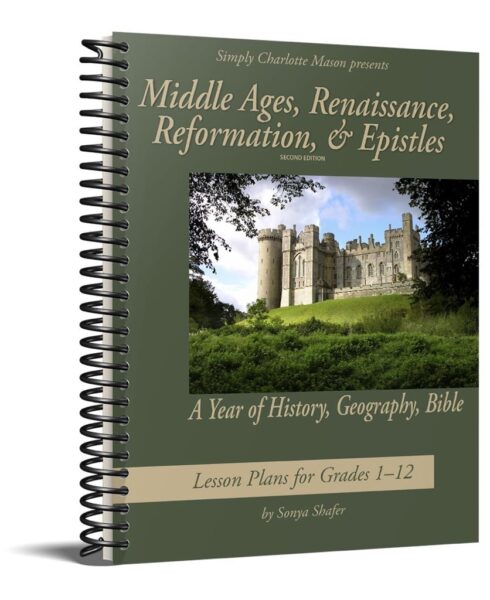Free shipping on USA orders over $129!
Middle Ages, Renaissance, Reformation & Epistles Links and Tips


The links below are related to our book Middle Ages, Renaissance, Reformation & Epistles. This study combines all your students, grades 1–12, for a full year of Bible, history, and geography. Be sure to check back here from time to time. We will be adding new and updated resources related to the book as we get them. If you have some resources that you’d like to recommend, let us know!
Complete Year’s Book List
See the complete list of books recommended in this study by grade level and with recommendations for where to find each book.
More on the Middle Ages, Renaissance, and Reformation
Dover Coloring Books
The pictures in these coloring books are quite detailed with a brief explanation on each one. Older students might want to use colored pencils or even watercolor paints.
Gregorian Chant
- This Wikipedia article contains a sample of a Gregorian chant to listen to when you learn about monks.
Bruce and the Spider Poem
- You may enjoy reading this Bruce and the Spider poem when you read about Robert Bruce.
Maps
These maps of Renaissance Italy may help older students as they read about the plots of Cesare Borgia.
- Colorful and simple map of Italy
- Broader map that sets Italy in context of Renaissance Europe
- Broad map that gives the context of Renaissance Europe with inset detail of Italy
Hands-On Project Ideas
Many hands-on activities are available if you would like to supplement your study of the Middle Ages, Renaissance, and Reformation. Here are some suggestions (in random order) with links to details.
Make a Model Castle
Several options are available for making your own model castle.
- Purchase a printed kit that you cut apart and glue together. Here’s another one.
- Free online pattern pieces and instructions that you can print, trace onto your own cardboard, and assemble are available at Your Child Learns and Storm the Castle.
- Take a look at these impressive castles built from Lego for some ideas.
A Medieval Feast
You’ll want to plan ahead for your medieval feast. Here are a few tips and some links to sites with recipes.
- Make the trenchers ahead of time (flat bread used instead of plates).
- Everyone must eat with their fingers, no utensils except maybe knives.
- Bones and scraps get thrown on the floor. (Well, you can decide how authentic you want to be. A drop cloth on the floor might be handy.)
- The pages and wenches serve the nobility.
- Musicians and minstrels can serenade those attending the feast. If you have time, you might compose your own poem or ballad to sing.
- Invite family friends or relatives if desired.
- Medieval Recipes
- Gode Cookery Medieval Recipe Translations
- A Medieval Theme Feast
A Coat of Arms
A coat of arms was a design that designated a knight’s connections and lineage. Use poster board and markers to create a unique coat of arms. Allow each child to design one or make one all together for your family. It’s fun if you can brainstorm symbols that represent the owner then try to combine the symbols into a pleasing design. Here are some examples of coats of arms. Sandi E. let us know about these two resources that she found helpful:
- The American College of Heraldry‘s chart on the meaning of different symbols used in heraldry
- Design Your Own Coat of Arms by Rosemary A. Chorzepa, published by Dover (ISBN 048624993X)
Chain mail
Of course, the original chain mail was much more intricate than most children can tackle. But your young students might enjoy these simplified chain mail instructions. Older students may be interested in seeing how one young man designed his own metal chain mail.
Stained Glass windows
- The detailed Stained Glass coloring book from Dover will give you an idea of actual stained glass windows in cathedrals all over Europe.
- The melted crayon method
- The clear acrylic sheet method
- The votive candle version
- The tissue paper method
Medieval and Renaissance Instruments
Research these pictures and explanations of Medieval and Renaissance musical instruments, then see if you can make some like them.
Illuminations
Design beautiful letters, called illuminations, like those used in hand-written books. (See Marguerite Makes a Book for more information.) Younger children can make simple illuminations with crayons. Older ones might like to try their hand at making their own inks to use, as well.
Visit a Renaissance Faire
Unfortunately, not all Renaissance Faires are wholesome. Do your research to find out if the Faire you are considering is child-suitable and as authentic as possible.
